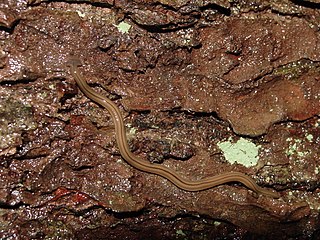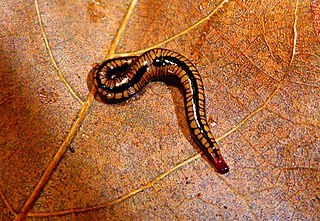
The New Zealand flatworm is a large land flatworm native to New Zealand. It can vary from 5 mm in length when hatched to approximately 17 centimetres (6.7 in) in mature adults.

Geoplanidae is a family of flatworms known commonly as land planarians or land flatworms.

Bipalium is a genus of large predatory land planarians. They are often loosely called "hammerhead worms" or "broadhead planarians" because of the distinctive shape of their head region. Land planarians are unique in that they possess a "creeping sole", a highly ciliated region on the ventral epidermis that helps them to creep over the substrate. Native to Asia, several species are invasive to the United States, Canada, and Europe. Some studies have begun the investigation of the evolutionary ecology of these invasive planarians.

Bipalium kewense, also known as the shovel-headed garden worm, is a species of large predatory land planarian with a cosmopolitan distribution. It is sometimes referred to as a "hammerhead flatworm" due to its half-moon-shaped head, but this name is also used to refer to other species in the subfamily Bipaliinae.

Girardia is a genus of freshwater planarians belonging to the family Dugesiidae.

Microplana is a genus of land planarians found in Europe and Africa.

Geoplaninae is a subfamily of land planarians endemic to the Neotropical region. Members of this family are sometimes referred to as the Neotropical land planarians. However, one species, Obama nungara has been introduced in Europe.

Bipaliinae is a subfamily of land planarians found mainly in Madagascar, the Indian subcontinent and Southeast Asia, although some species have been introduced worldwide.

Caenoplanini is a tribe of land planarians in the subfamily Rhynchodeminae mostly found throughout the Australasian and Oceanian realms.
Eudóxia Maria Froehlich was a Brazilian zoologist.

Amaga is a genus of land planarians from South America.

Anzoplanini is a tribe of land planarians in the subfamily Rhynchodeminae.

Marionfyfea is a genus of land planarians from Antarctic Islands off New Zealand. However, a species has been described from specimens found in Europe, probably introduced.

Othelosoma is a genus of land planarians found in Africa and India.

Marionfyfea carnleyi is a species of land planarian from Sub-Antarctic Islands of New Zealand.
Anzoplana is a genus of land planarians from Australia, currently comprising a single species, Anzoplana trilineata.
Eudoxiatopoplana is a genus of land planarians from New Zealand, currently comprising a single species, Eudoxiatopoplana bilaticlavia, that occurs in Stewart Island. It is the sole genus of the tribe Eudoxiaotopoplanini.

Microplana scharffi is a species of free-living, terrestrial flatworm in the order Tricladida. It was first described in 1899 by the Austrian zoologist Ludwig von Graff.

Marion Liddell Fyfe was a New Zealand academic, specialising in taxonomy of planarians and other flatworms, the first woman zoology lecturer at the University of Otago, and the first woman to be elected to the Council of the Royal Society Te Apārangi.
Argaplana is a genus of land planarians, the only member of the tribe Argaplanini in the family Rhynchodeminae. It contains the sole species Argaplana ranuii. It is native to New Zealand.














